- Luật
- Hỏi đáp
- Văn bản pháp luật
- Luật Giao Thông Đường Bộ
- Luật Hôn Nhân gia đình
- Luật Hành Chính,khiếu nại tố cáo
- Luật xây dựng
- Luật đất đai,bất động sản
- Luật lao động
- Luật kinh doanh đầu tư
- Luật thương mại
- Luật thuế
- Luật thi hành án
- Luật tố tụng dân sự
- Luật dân sự
- Luật thừa kế
- Luật hình sự
- Văn bản toà án Nghị quyết,án lệ
- Luật chứng khoán
- Video
- NGHIÊN CỨU PHÁP LUẬT
- ĐẦU TƯ CHỨNG KHOÁN
- BIẾN ĐỔI KHÍ HẬU
- Bình luận khoa học hình sự
- Dịch vụ pháp lý
- Tin tức và sự kiện
- Thư giãn

TIN TỨC
fanpage
Thống kê truy cập
- Online: 13
- Hôm nay: 948
- Tháng: 6431
- Tổng truy cập: 5151695
2017 timeline contents
The European Union has been expanded
Worsening crisis in Yemen
China establishes the largest megacity in the world
The world's first kilometre-high skyscraper
A new tallest building for Los Angeles
The world's first Floating Liquefied Natural Gas (FLNG) platform begins operations
The Nabucco gas pipeline is completed
India completes construction of the Dibang Dam
The M1A3 Abrams tank enters the battlefield
The remaining JFK files are released
Total solar eclipse in the US
China launches an unmanned sample return mission to the Moon
The first test flight of NASA's Space Launch System
The first manned flight of the Dream Chaser
Launch of the Transiting Exoplanet Survey Satellite (TESS)
The Cheops satellite is deployed to study exoplanets
The world's first lunar tourist
Sales of electric and hybrid trucks reach 100,000 annually
10 nanometre chips enter mass production
Web-connected video devices exceed the global population
Electronic paper is seeing widespread use
Traditional newspapers are becoming obsolete
Tooth regeneration is transforming dental care
Cosmetic surgery has doubled its market size
Wireless, implantable devices that monitor a range of health conditions in real time
The world's first HIV vaccine is commercially available
A new treatment for prostate cancer
BioCassava Plus receives regulatory approval
The world's largest mud volcano stops erupting
2017
The European Union has been expanded
By this date, the countries of Iceland, Macedonia, Croatia, Bosnia and Herzegovina, Montenegro, Albania and Serbia have all joined the ranks of the EU member nations.** This follows several years of negotiations in order to bring these countries in line with the rest of the Union, in terms of economics and law.*
The process a country must undergo in order to join the European Union may take several years, often involving a long series of debates over the economic and political costs versus benefits. In order to become a recommended candidate, a country must be located in Europe and must be a stable, humane and democratic nation. According to the Copenhagen Criteria, a candidate must have a democratic government with respect for human rights and minorities, a functioning and secure market economy, as well as the ability to take on the obligations of membership concerning political, monetary and economic union.
Iceland was among the first to enter the Union. Prior to the 2008 economic crisis, public support for joining was low, with many viewing it as unnecessary. At the time, Iceland was only a member of the European Economic Area. Following the global economic downturn of 2008, the Icelandic economy crashed, with three of the country's largest banks failing and unemployment rates and debt levels spiking.* Because of its well-established democracy and market economy, Iceland was made a priority in regards to the next EU expansion.* Although some issues persisted – such as whale hunting, fishing and agriculture* – it was eventually welcomed into the EU.
Around the same time, Macedonia succeeded in joining too. This came only after tensions with its neighbour Greece were finally resolved. Greece had blocked Macedonia's accession for some time, over an issue concerning the country's title.* The country had also been criticised for its treatment of the Albanian minority, something it was required to immediately reform. As with most new members, negotiations over economic issues were also required upon Macedonia's adoption of the euro.
Croatia was another early addition to the Union, entering in mid-2013.* It became the second ex-Yugoslav country to join after Slovenia. Croatia was also made a priority, with heavy support coming from its neighbour Hungary. Before its accession, Croatia was required to settle its ongoing border dispute with Slovenia, which had for ten months blocked the country's EU negotiation. There were also several issues regarding cooperation with the International Criminal Tribunal for the Former Yugoslavia over prosecuting crimes against humanity. Crackdowns on government corruption had to be carried out too. Regarding the global financial crisis, Croatia had fared relatively well, though large portions of its economy were still under direct control of the government, something which had to change in order to meet the EU's stringent requirements. By 2017, it is also dealing with a high level of international debt, showing that Croatia was just slower to be affected by the crisis. Complex negotiations were required once the euro was introduced as the country's currency.
In a similar situation was Bosnia and Herzegovina, also located in the Balkan Peninsula. The country joined in 2015,* shortly after joining NATO.* One of its largest concerns was the ongoing ethnic quarrels that were remnants of the Bosnian War. In fact, the EU had maintained a peacekeeping force in the country for over a decade. For some time, the nation had also received stabilising loans from the EU. Corruption and organised crime were major problems too. Before joining the EU, Bosnia was forced to make drastic changes to its domestic and political policies. By 2017, however, the country has made significant strides towards becoming a fully developed country. Although it still faces challenges, these are more easily handled now through the advantages of EU membership.
The same year that Bosnia and Herzegovina joined, both Albania and Montenegro entered the European Union and the eurozone. Albania was, like Bosnia, plagued by organised crime and corruption.* Alongside this, it was home to significant ethnic discrimination – a symptom of residual tension left over from past racial and religious conflicts. With regards to its economy, Albania had to overcome the remnants of communism and establish a truly free market system in order to comply with the EU's standards. This meant going through a period of reforms to the government, justice system and media in the early 2010s, inhibiting ethnic bias and political disorder.
Montenegro was in a similar position, itself being a haven for trafficking and money laundering. It had only recently moved to a market economy, having become independent in 2006. Before its accession, it was required to increase protection of freedom of expression, strengthen diplomatic relations with Serbia and comply with other membership criteria. The country made good progress, however,* and was later admitted. An important milestone on its path to EU membership was reached towards the end of 2009, when its citizens were granted the right to visa-free travel within the Schengen zone.
The last country to join at this time was Serbia. For a prolonged period, Serbia's progress towards membership had remained sluggish, made worse by the long history of ethnic conflict between it and certain other EU candidates. Many members were wary of letting Serbia join and applied strict conditions for it to do so – including justice over the atrocities committed by certain Serbs in the Bosnian War. Despite this, appeals to the West eventually pushed Serbia's application forward.* A number of barriers were removed during the accession process.* Of the many problems facing Serbia, unemployment and a high trade deficit were the most pressing. A series of financial reforms, many of which would continue through 2017, were begun. Serbia was also forced to compromise on the issue of Kosovo's independence, which had also begun to apply for EU membership.*
Although a long-time candidate, Turkey is still a few years away from gaining full EU membership. Despite bringing a huge population and strong economy to the table, lack of compliance with EU laws and a conflict over Cyprus have slowed its progress considerably.
These seven countries are some of the last new members to enter into the EU. Recent economic turmoil has made the Union increasingly cautious in allowing new economies to join. As of 2017, it has a total of 34 member states and a population of more than half a billion. It remains a leading world power for now – but with ongoing economic issues that have yet to be resolved.
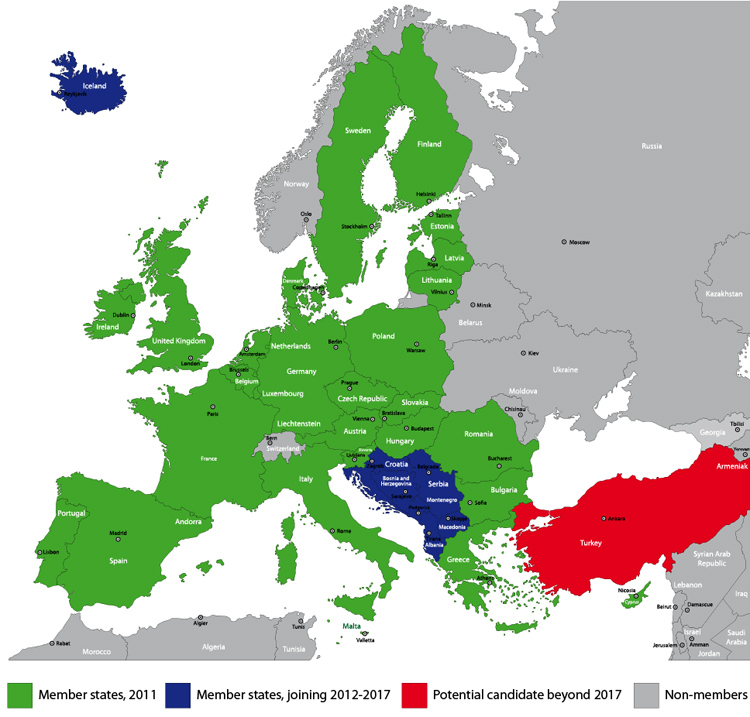
Worsening crisis in Yemen
At the turn of the 21st century, Yemen was already the poorest and least developed nation in the Arab world. Nearly 45% of its citizens were living below the poverty line, unemployment was running at 35% and its literacy rate was just 58%. It had dwindling natural resources and a ballooning population. Its economy was heavily reliant on hydrocarbons, which accounted for almost 75% of government revenues and 90% of foreign exchange earnings.
Yemen reached peak oil production in 2003 and witnessed a steady decline thereafter. In 2011, a popular uprising erupted due to worsening economic conditions, rising unemployment and government corruption. This was sparked by simultaneous protests in other Middle Eastern countries.
Over the next few years, the situation continued to deteriorate. Power blackouts and food shortages became a daily norm, while motorists were forced to queue their vehicles for hours at petrol stations. The country had no apparent way of transitioning to a post-carbon economy. Its neighbour, Saudi Arabia, attempted to stabilise the political and economic situation by donating oil. By the middle of the decade, however, Saudi Arabia itself was experiencing shortfalls, meaning it could no longer offer this support. Yemen's push into the gas sector had also failed to revive its economy significantly.
Alongside this, a new and even greater threat was emerging. Yemen's groundwater levels had fallen sharply in recent decades. Around the capital, Sana'a, borehole drilling was now reaching down to water that fell more than 8,000 years ago, with groundwater levels decreasing by 4-6 metres a year. Additional wells and water mains were desperately needed to service the region, but these for the most part had been lost among the nation's various other problems. Yemen had been battling Shiite Muslim rebels in the north and a separatist movement in the south, whilst contending with a resurgence of Al Qaeda and the scourge of piracy in the Gulf of Aden.
By 2017, a calamity is unfolding. Oil and gas reserves have now dwindled to zero* and Sana'a has become the first capital city in the world to completely run out of water.* The situation has been made worse by rising fuel prices. Trucks bringing supplies from outside are no longer able to make up the shortfall – resulting in widespread looting, rioting and violence. This soon gives way to starvation, a mass exodus of refugees and a rapid decline in the country's population which continues into the following decade. The state collapses into anarchy, with a zone of lawlessness expanding into Saudi Arabia and the Horn of Africa.
The outside world watches, powerless, as this tragedy unfolds. Though assistance is offered by other countries, including some military intervention, it cannot prevent a humanitarian catastrophe. Yemen now faces a very uncertain future, threatening stability across the region.
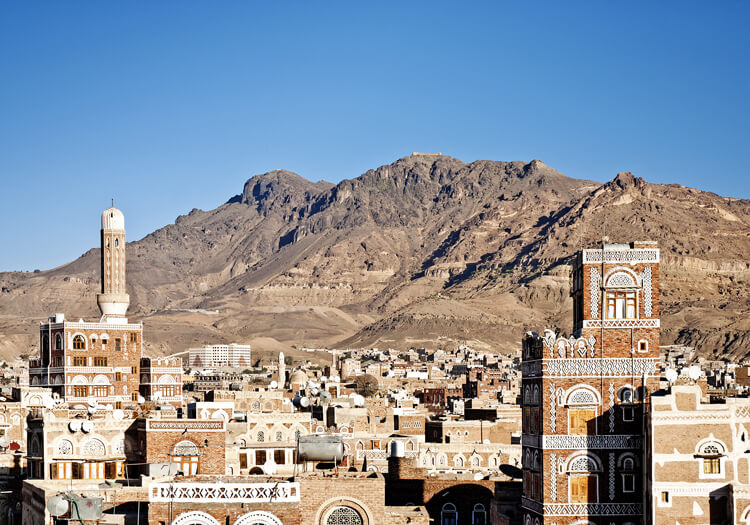
2017: Yemen's water crisis and oil shortages have left the country in chaos.
China establishes the largest megacity in the world
By now, China has merged nine of its cities into one, creating the largest metropolitan area on the planet. This new megacity has a population of 42 million – over 7 million greater than Tokyo, the previous record holder.
The cities being merged include Guangzhou and Shenzhen, the second and third largest cities in China with populations of 11.7 million and 8.9 million, respectively. This region covers much of China's manufacturing heartland, accounting for nearly a tenth of the Chinese economy.
Around 150 major infrastructure projects have meshed the transport, energy, water and telecommunications networks of these nine cities together, at a cost of some 2 trillion yuan ($304 billion). An express railway line connects the hub with nearby Hong Kong.*
By the end of the decade, even larger megacities are emerging, with city zones of up to 100 million people.
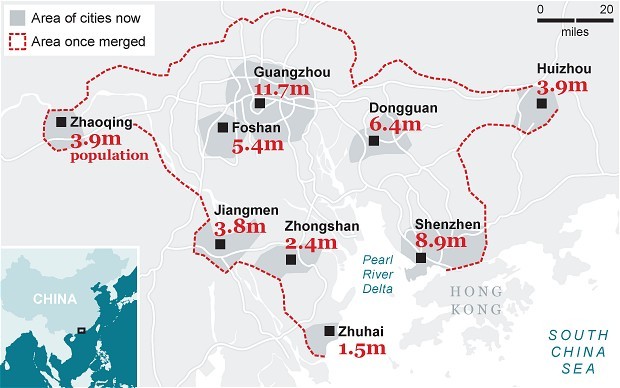
The world's first kilometre-high skyscraper
After a six year construction period, the Kingdom Tower opens in Jeddah, Saudi Arabia.* Standing at over 1,000m (3,280 ft) high, this takes the title of world's tallest building from the previous record holder – the Burj Khalifa in Dubai, which stands at 830m (2,772 ft).
The tower is designed by Adrian Smith + Gordon Gill Architecture, the firm behind the Burj Khalifa, and is developed by Emaar Properties. The project costs $1.2 billion, actually less than it cost to build the Burj Khalifa. The skyscraper has over 200 floors – a world first – and 59 elevators. It contains some 5.7 million square feet of retail, residential, office and hotel space and hosts the world's highest observation deck.*
Reusing the successful Y-shaped footprint of the Burj Khalifa allowed construction to reach higher than ever before. In order to handle the tremendous weight, new concrete formulas were devised. As the building rose, lighter and lighter materials were used. The sloping design, along with massive counterweights placed strategically throughout the tower, help to offset the strong winds present at such heights, which can often reach over 120 mph.*
Kingdom Tower becomes the centerpiece of the $20 billion "Kingdom City" development that essentially becomes an entirely new district of Jeddah. Public opinion is polarised. Many view it as a positive symbol of the power and wealth of Saudi Arabia. Others see it as a white elephant, believing it will ultimately prove to be a financial loss.
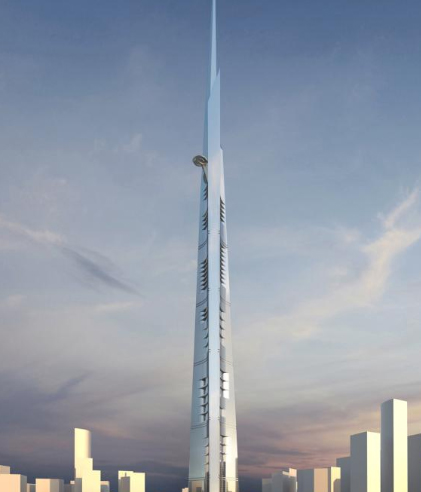
Credit: ASGG
A new tallest building for Los Angeles
The skyline of Los Angeles is dramatically altered this year with completion of the Wilshire Grand Center – a new supertall skyscraper in the financial district. At 335 m (1,100 ft) and with 73 storeys, it becomes the tallest building in the Western U.S., surpassing the U.S. Bank Tower which had held the title since 1989. It comprises a mixed-use hotel, retail and office complex, intended to revitalise downtown and the area surrounding the building. High-speed elevators carry visitors to a "sky lobby" within 45 seconds, offering unparalleled views of the city and a rooftop infinity pool. At ground level, the project includes a new urban plaza and park.*
Developed by Korean Air, the Wilshire Grand Center was in the planning process for 25 years. Upon completion, its facade is illuminated at night by advertising displays, emulating the style of many towers located in the megacities of East Asia. These LED systems – along with new green building techniques and materials – significantly reduce overall energy consumption.*
Click to enlarge
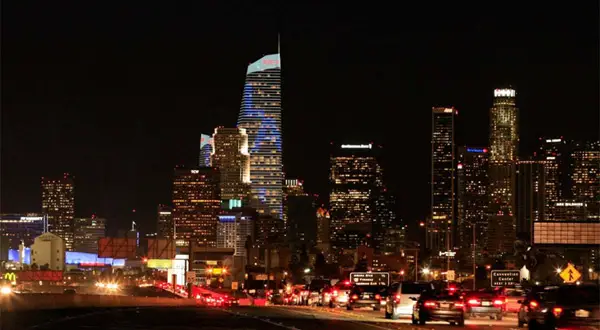
CGI rendering from the Environmental Impact Report [PDF]. Credit: AC Martin / Rios Clementi Hale.
The first Floating Liquefied Natural Gas (FLNG) platform begins operations
Due to the remoteness of many deepwater natural gas resources, large-scale exploitation of these areas has been next to impossible. A new project, however, undertaken by Royal Dutch Shell, seeks to overcome these barriers. The Floating Liquefied Natural Gas (FLNG) platform, as it is called, begins operations this year off the coast of Northern Australia over Shell's Prelude natural gas field.
Essentially the world's largest "ship," the FLNG is anchored over several well heads in the isolated field, in water around 250 meters deep. It pumps up natural gas continuously, storing it within several massive tanks, chilled at -162°C which compresses its volume by 600 times. Every week, a gas tanker arrives to off-load the FLNG's stores. When fully loaded, the ship contains 600,000 tonnes of liquefied natural gas. It produces at least 5.3 million tonnes per annum (mtpa) of liquids: 3.6 mtpa of LNG, 1.3 mtpa of condensate and 0.4 mtpa of LPG. It is 488 metres long – equivalent to four soccer fields laid end to end.*
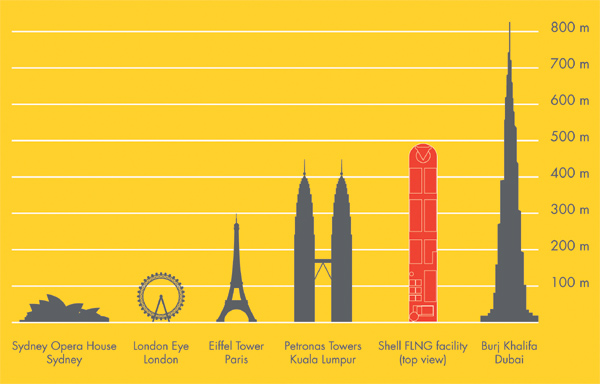
The facility is operated by a crew of 120 and costs around $10 billion to build. This mega-project capitalises on the growing demand and prices of natural gas, particularly in China. Most of the advantage of a floating gas platform has to do with the lack of permanent infrastructure. Not only is it easy to move when a field runs dry (as Prelude will do in 25 years), but it is more capable of dealing with the dangerous cyclones often present in the area.
The project does have some detractors however. Environmentalists have expressed concerns over the damage the FLNG could do to the ecosystem. Despite these issues, several more such platforms are constructed over the following decades.*
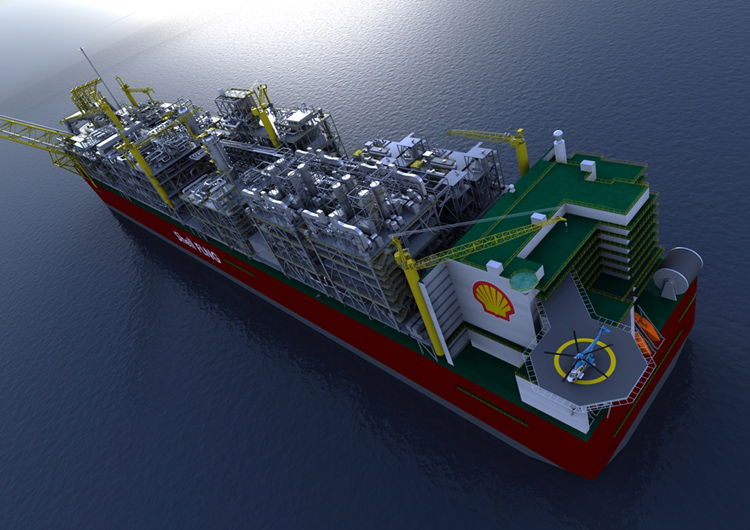
Credit: Shell
The Nabucco gas pipeline is completed
The controversial Nabucco pipeline commences operations this year.* This project had been in the planning stages since 2002 and was backed by the United States and the European Union, but financial issues and a lack of definite supply contracts caused continual delays. As a result of these problems, construction did not begin until 2013, after it became certain enough gas would be available to turn a profit.
The pipeline is over 2,500 miles long. It begins in eastern Turkey and then travels up through the Balkans, through Bulgaria, Romania, Hungary and finally into Austria. The main supply originates from Iraq, as well as Azerbaijan and Turkmenistan, both of which have opened several new fields in recent years. Once fully operational in 2017, over 31 billion cubic meters of natural gas begin to pass along the pipeline. This gives Western Europe more direct access to the energy resources of the Middle East and Caspian Sea, as well as helping to lessen the continent's dependence on Russia. In a similar manner to the new floating liquefied natural gas platform design, the Nabucco pipeline supports the growing demand for natural gas, primarily in the West.
The controversy surrounding the project is mainly political and economic. Concerns were raised over whether the actual amount of gas passing through the pipeline would make up for the high cost of construction (almost €15bn). Several countries believed that Nabucco would only benefit a few European nations. Indeed, the initial flow is less than optimal, and it will be several more years before the project can be called economically worthwhile.
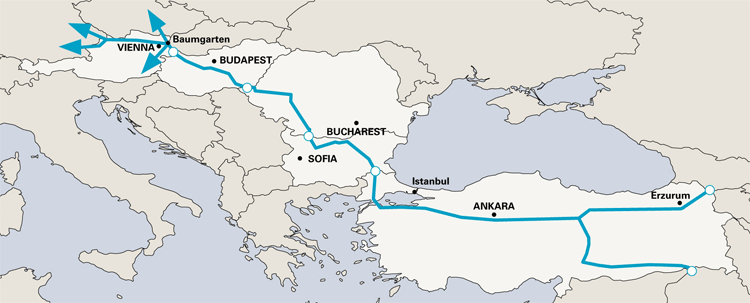
India completes construction of the Dibang Valley Dam
Yet another energy project making the headlines this year is the Dibang Dam, in northeast India. At 288m high, this becomes the tallest concrete gravity dam in the world. It has a volume of 16.5 million cubic metres and can generate 3,000 MW of electric power.*
The project is not without controversy, however. There has been strong local opposition, due to the relocation of indigenous tribal communities, environmental damage, and questions being raised about its safety along with that of other nearby dams.* Over 100 are being constructed in Arunachal Pradesh during this time – 17 in the Dibang Valley – as hydroelectric power gains momentum.* Tensions have also been raised with China, which is building dams of its own in the region, threatening to reduce the flow of water to India's territory.*
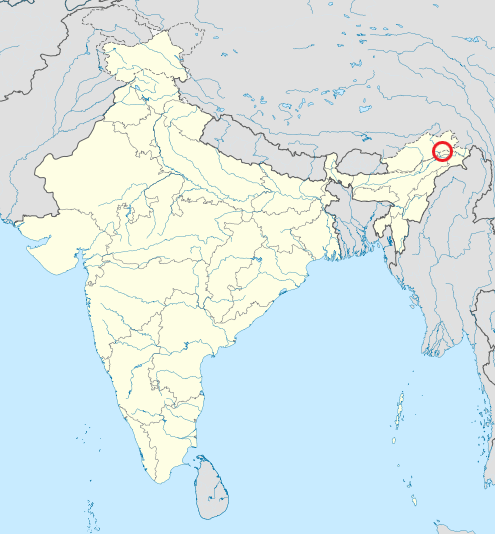
Credit: Uwe Dedering
The M1A3 Abrams tank enters the battlefield
The original M1 battle tank – a third generation vehicle – was introduced to the U.S. Army in 1980. Since then, variants of the tank, primarily the M1A1 and M1A2, have seen extensive use in battle. They first entered combat in Operation: Desert Storm, during the Persian Gulf War, and have been used in every American military conflict since. They have also become the principal tank of the Saudi Arabian, Egyptian, Kuwaiti and Australian armies, as well as the Army of Iraq following arms deals made with the United States.
The newest generation of the M1 – the M1A3 – is fielded this year.* The first prototypes were completed in 2014. Now, in 2017, they are entering the battlefield, primarily in the remaining American conflicts in the Middle East (which have dragged on in some areas for longer than expected).*
Various design improvements have been made. These include the latest in armour and ballistic shielding, of course, especially the underbelly armour, as well as hi-tech computer networking. The tank has been reduced in weight by almost one-fifth, providing more capability for crossing bridges. Its ammunition has also been upgraded, with new ultra-accurate computer guided missiles.*
This comes at a difficult financial time for the Marine Corps, which is forced to cut back their tank fleet and partner with the Army concerning the M1A3. Over the next few decades, the M1A3 will remain among the favourite battle tanks of the US and others.*
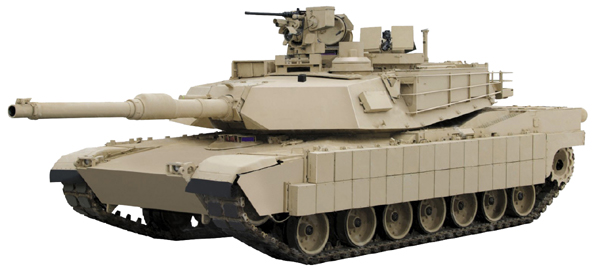
The remaining JFK files are released
The Assassination Records Review Board was created as a result of an act passed by the US Congress in 1992, entitled the "President John F. Kennedy Assassination Records Collection Act". This Act mandated the gathering and release of all government records relating to the assassination of John F. Kennedy.
The Act was passed following the public outcry about the assassination, after the 1991 premiere of Oliver Stone's film JFK, which proposed Kennedy assassination theories involving plots to kill the President. The ARRB collected evidence starting in 1992, then produced a final report in 1998.
The ARRB was not commissioned to determine why or by whom the murder was committed. Its purpose was simply to release documents to the public, in order for the public to draw its own conclusions. From 1992 until 1998, 60,000 documents were gathered and unsealed, consisting of more than 4 million pages. All remaining documents are released by 2017.*
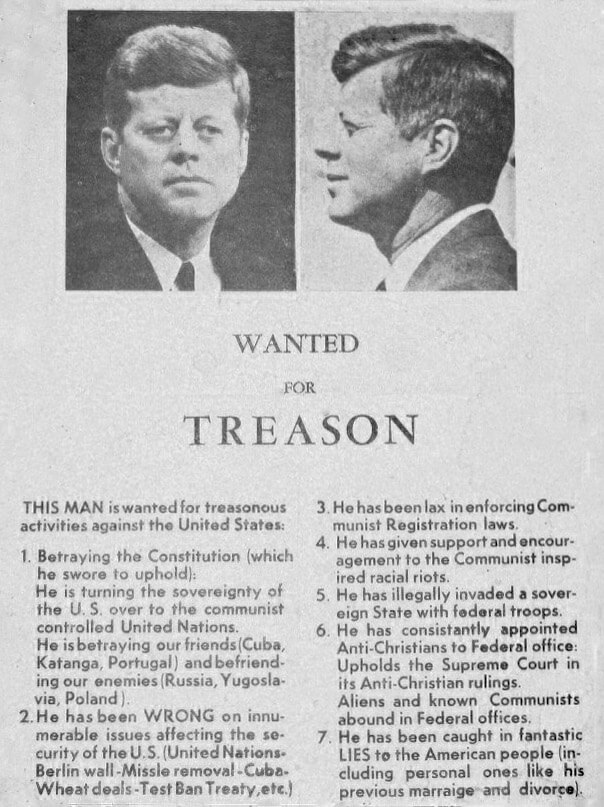
A handbill circulated on 21 November 1963, in Dallas, one day before the assassination of John F. Kennedy.
Total solar eclipse in the USA
On 21st August this year, a total eclipse occurs in the United States, the first visible from the US since 1991 (just from part of Hawaii), and the first visible from the contiguous US since 1979. Totality occurs along a path curving from Oregon to South Carolina, lasting roughly 2 minutes and 40 seconds. The location and time of "greatest eclipse" is on the western edge of Christian County, Kentucky at 36.97 degrees North and 87.65 degrees West, occurring at 18:25 UTC.
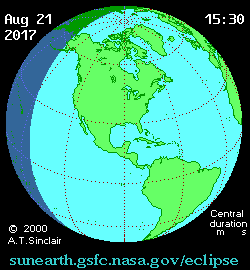
Credit: NASA
China launches an unmanned sample return mission to the Moon
Following the success of its first lunar lander in 2013, China attempts a more ambitious sample return mission.* Launched in 2017, this obtains about 2 kg (4 lb) of moon rock, bringing it back to Earth for study.
The robot deployed on the surface has a mission life of three months. It can choose its own routes, avoid obstacles and perform experiments with a mechanical arm. It comes equipped with a suite of sensors including cameras, X-ray and infrared spectrometers and a ground-penetrating radar. It has solar panels and a supplementary power source for night work in the form of a plutonium-238 nuclear battery – the same type of radioisotope thermoelectric generator system (RTG) installed on NASA's Mars Science Laboratory.
China has big plans for beyond 2017. The country intends to build its own space station by 2022,* send humans to the Moon by 2025* and construct a lunar base shortly thereafter.
The first test flight of NASA's Space Launch System
The Space Launch System, or SLS, is a Shuttle-derived heavy launch vehicle designed by NASA, following the cancellation of the Constellation Program, to replace the Space Shuttle. The NASA Authorization Act of 2010 envisioned the transformation of the Ares I and Ares V vehicle designs into a single launch vehicle usable for both crew and cargo. It would be upgraded over time with more powerful versions.
The SLS will carry the Orion Multi-Purpose Crew Vehicle, as well as important cargo, equipment and experiments to Earth's orbit and destinations beyond. Additionally, it will serve as a backup for commercial and international partner transportation services to the International Space Station. It could also be used on missions to repair telecom satellites, at orbits 36,000 km above the Earth which were previously inaccessible to astronauts.*
The rocket design incorporates technology from the Space Shuttle and Constellation Programs, taking advantage of proven hardware and cutting-edge tooling and manufacturing technology that greatly reduces development and operations costs. It is powered by a liquid hydrogen and liquid oxygen propulsion system, including the RS-25D/E from the Space Shuttle Program for the core stage and the J-2X engine for the upper stage.*
It has an initial lift capacity of 70 metric tons; nearly three times that of the Space Shuttle. The first unmanned developmental test flight takes place in 2017, with a manned trip around the Moon scheduled for 2021. Its payload will evolve as more advanced versions are developed; it is ultimately hoped to reach 130 tons in the early 2030s.** This will enable the first manned missions to Mars.*
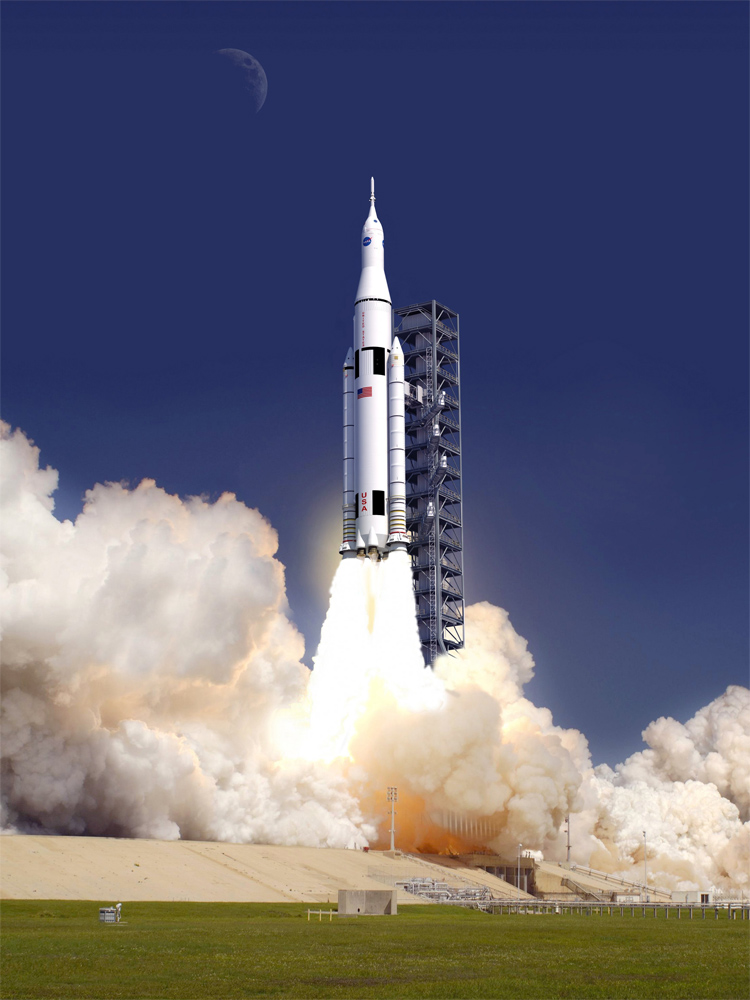
The first manned flight of the Dream Chaser
The Dream Chaser is a space plane being developed by Sierra Nevada Corporation (SNC) Space Systems. Intended to carry up to seven astronauts, it provides low-cost, commercial transportation services to and from low Earth orbit, including the International Space Station (ISS). This vehicle, resembling a mini-Space Shuttle, launches vertically on an Atlas V rocket and can land horizontally on conventional runways. It is designed for simple maintenance and quick turnaround. An unmanned demonstration occurs in 2016, with manned operations beginning in 2017 – ending U.S. dependence on Russian Soyuz spacecraft to provide an orbital taxi service.*
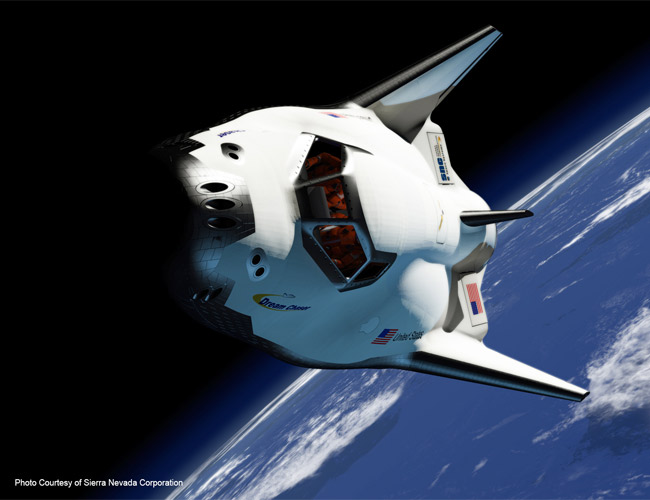
Launch of the Transiting Exoplanet Survey Satellite (TESS)
The Transiting Exoplanet Survey Satellite (TESS) is a space telescope intended to search for extrasolar planets using the transit method. It is part of NASA's long-running "Explorer" program which has been going since 1958 and involves working with a variety of other institutions and businesses. In this case, the $200m project is led by the Massachusetts Institute of Technology, with seed funding from Google.
Equipped with four wide-angle telescopes and charge-coupled device (CCD) detectors totalling 192 megapixels, TESS conducts a two-year all-sky survey focussed on nearby G- and K-type stars with apparent magnitudes brighter than 12. Around 500,000 are studied – over triple the 156,000 that Kepler was designed to observe – including the 1,000 closest red dwarfs. The region of sky covered is also 400 times bigger.*
Several thousand Earth-sized and larger exoplanets are identified, adding to the already huge tally from Kepler. Many of these candidate worlds are later investigated by the James Webb Telescope and other future missions which enable more detailed analysis of their masses, sizes, densities, orbits and atmospheres. In this same year, Europe launches its own similar mission – the Cheops satellite (see below).
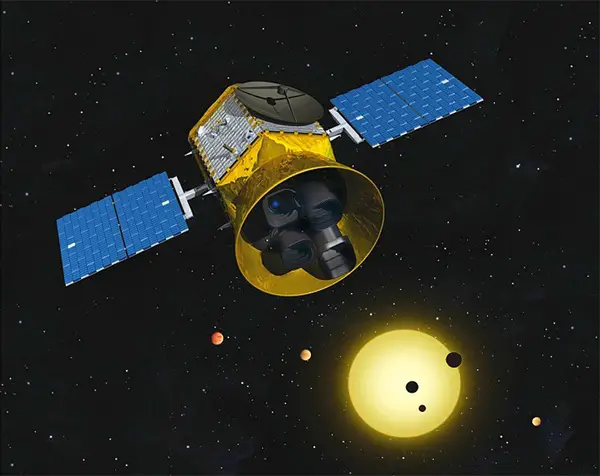
Credit: MIT Kavli Institute for Astrophysics and Space Research
The Cheops satellite is deployed to study exoplanets
In 2017, the European Space Agency (ESA) launches a new satellite to study exoplanets. Its focus of study is nearby star systems already known to host planets. The small CHaracterising ExOPlanets Satellite, called Cheops, operates in a Sun-synchronous low-Earth orbit at an altitude of 500 miles (800 km) and has a mission lifetime of around 3.5 years. It is powerful and precise enough to form accurate measurements of a planet's radius, as well as determining the likely density and internal structure.* The mission also provides unique targets for more detailed studies of exoplanet atmospheres by the next generation of telescopes now being built, such as the ground-based European Extremely Large Telescope and the James Webb Space Telescope.
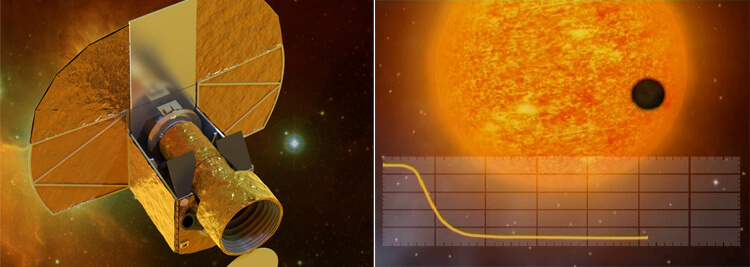
Credit: University of Bern/CERN
The world's first lunar tourist
In 2001, Dennis Tito became the world's first space tourist, spending eight days on the International Space Station and orbiting the Earth a total of 128 times. Tito paid a reported $20 million for his trip, through an arrangement with space tourism company Space Adventures Ltd.
A number of startup companies sprang up in subsequent years in the hope of creating a space tourism industry. These included Virgin Galactic, using suborbital spacecraft designed by Scaled Composites and launched from Spaceport America in 2014. At a cost of $200,000 each, civilians could journey to a height of 110 km (68 miles), experiencing up to six minutes of zero-G whilst looking down on the Earth.
Other plans included an orbital hotel by Russian firm Energiya in partnership with US firm Orbital Technologies,* along with a "budget" space plane offered by Swiss Space Systems and planned to commence by 2020.*
Space Adventures was looking further, however, setting its sights on even more daring and ambitious ventures. From 2017, the company offers the first lunar orbits to paying tourists. For $150 million, passengers can travel beyond Earth orbit, enjoying circumlunar trips and viewing the Moon from just 100 km (62 mi) above its surface – as well as viewing the famous Earthrise.* Prior to this service, only 24 people had ever experienced this view. Space Adventures' craft is also larger and more comfortable than those used during the Apollo program.
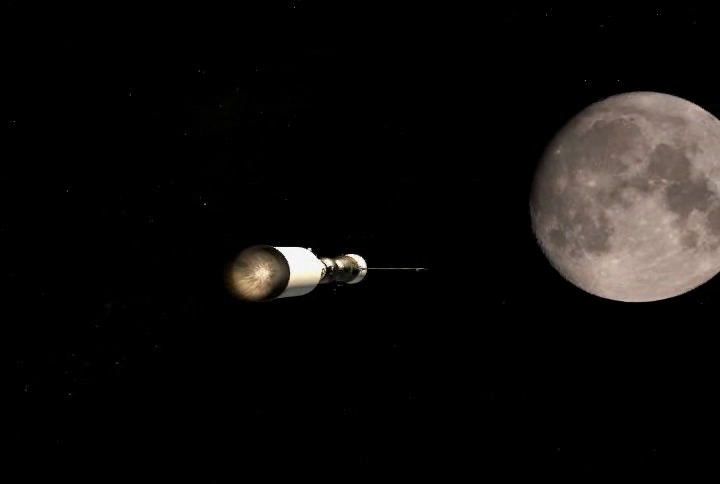
Credit: Space Adventures
Sales of electric and hybrid trucks reach 100,000 annually
Electric and hybrid trucks are now surpassing 100,000 in annual production numbers worldwide.* This includes hybrid electric vehicles, plug-in hybrids, battery-electric and plug-in electric power take-off variations.
Between 2011 and 2017, the overall truck market grew at roughly 4% per year. However, the market for hybrid and electric trucks grew almost 12 times as fast, at 47%. This was partly in response to oil and gas volatility, but was also due to significant technology improvements and, in particular, the falling price of batteries.
The overall cost of hybrid and electric vehicles remains the largest barrier to full market proliferation, but this has improved markedly in recent years, with new battery technology that increases a vehicle's speed and range.* Progress has also been made in the time it takes to recharge,* as well as the availability of electric charging points (now 7.7 million worldwide).* Motors are also becoming available without the need for rare earth metals.*
The largest market for these trucks is still Asia Pacific, with around 41,000 being sold each year. Slowly catching up is North America, where the number is approaching 26,000. As oil prices increase, hybrid and electric trucks will eventually become more cost-effective than fossil fuel-driven ones. Technology in general continues to reshape the shipping industry. Manufacturers are looking into the possibility of driverless, fully automated vehicles, for example.*
The environmental benefits of going electric are potentially huge, as trucking makes up a significant portion of transport emissions, which cumulatively produce over 13% of the world's CO2 emissions.*
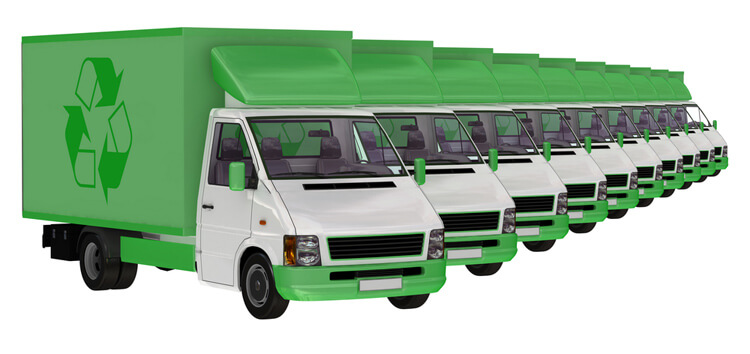
10 nanometre chips enter mass production
In 2017, the next generation of microprocessor technology is released by Intel, with transistors using a 10 nanometre (nm) manufacturing process* – superseding the 14 nm process. Codenamed "Cannonlake", this family of processors is based on a die-shrink of Intel's Skylake CPU microarchitecture. More than 10 billion transistors can now be packed onto a single chip – bringing greater CPU and GPU performance, and reduced power consumption for computers, phones, tablets and other electronic devices. Moore's Law will soon be hitting a wall, however, as the effects of quantum tunnelling begin to degrade chip performance at such tiny scales. Traditional silicon circuits will reach their limit in the early 2020s, with a new paradigm emerging in the form of graphene and other concepts.
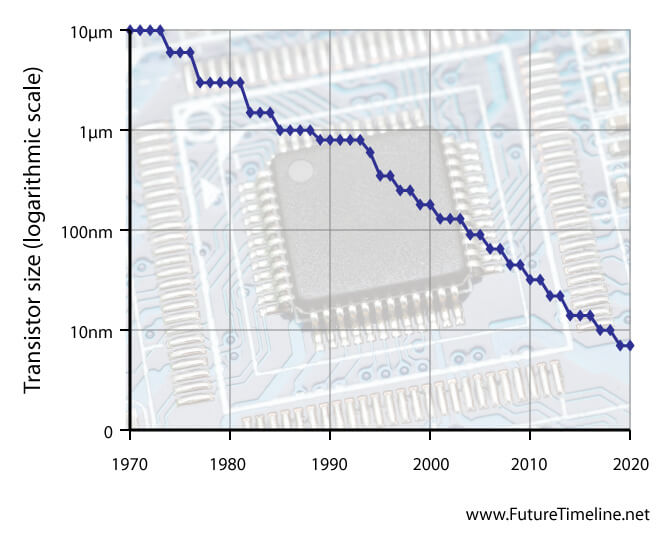
Web-connected video devices exceed the global population
More than 8.2 billion Internet-connected video devices are now installed worldwide, exceeding the population of the planet. This category includes a diverse range of products such as tablets, smart TVs, games consoles, smartphones, connected set-top boxes, Blu-ray players, laptops and PCs. With around 7.4 billion people it is equivalent to 1.1 devices for every global citizen, nearly double the number in 2013. The fastest growth has occurred in the Asia-Pacific region, driven largely by Chinese demand.*
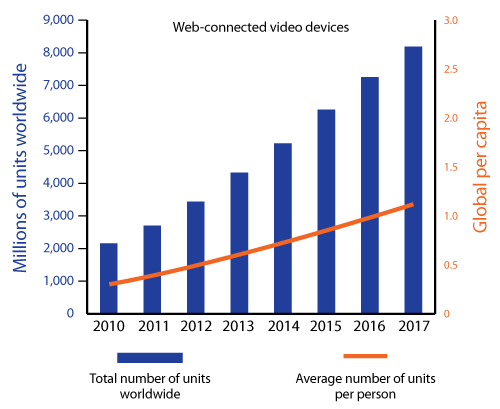
Electronic paper is seeing widespread use
This technology has been in development for over a decade* and is now seeing widespread use.* It works by combining organic, thin film transistors (TFT) with organic, electroluminescent displays. This produces flexible, paper-thin devices barely 0.3mm in thickness.
Early applications included the first e-readers, but more sophisticated products have now emerged, some capable of running high-quality video. Ultra-thin smartphones, clothing and textiles with electronic displays, video ID cards, video leaflets, road signs that are self-illuminating, video instructions on food and other packaging – these are just some of the items to feature this technology.
Further development leads to much greater contrast ratio – resembling printed paper more than a screen (the latter is hard to see in direct sunlight). This technology also marks a step towards the paperless office, which in turn will reduce deforestation.
Traditional newspapers are becoming obsolete
The Internet has continued to erode the market share held by other forms of media. Since passing television as the primary source of news reporting in developed nations,* it has taken on more and more functions.
The vast array of sources now found online – coupled with growing advancements in mobile and other technologies – is heavily impacting the ratings for mainstream news stations. Online videos, blogs and web series are now seriously competing with the best and most watched TV shows.
Capital-intensive overheads, together with slumping ad sales, have been further contributory factors in the decline of large media companies. A number of newspaper corporations have already gone under, while others – including the New York Times and the Daily Telegraph – have been forced to transition to a digital form, in some cases at great monetary loss.*
Slowly, newspapers throughout the developed world are becoming financially unsustainable and going out of print. The United States is leading this trend, where the collapse of the traditional newspaper has been most obvious. Following close behind are several countries in Europe. The UK and Iceland are the first in which newspapers begin to fall out of use. While physical news is still present in these countries, it is very sparse.
Newspapers will become obsolete in Australia by 2022, followed by Asia and South America, and finally Africa and the remaining countries beyond 2040.*

Tooth regeneration is transforming dental care
Having been demonstrated in mice,* bioengineered tooth regeneration is becoming available to humans.* A combination of stem cells, scaffold material and signalling molecules can be used to regrow a fully functional, living tooth in around two months – complete with roots, inner pulp and outer enamel. Until now, dental implant therapies had required pre-existing, high quality bone structures to support the artificial implants. Full reconstruction of natural, healthy teeth in patients without adequate bone support is therefore now possible.
Another technique to emerge this year is Electrically Accelerated and Enhanced Remineralisation (EAER). This allows a decayed tooth to effectively repair and heal itself without the need for drills, needles or fillings. This breakthrough procedure uses electrical stimulation to help teeth "remineralise" by pushing minerals like calcium and phosphate back into the tooth to repair the damaged site.*
Fillings and dentures will gradually become obsolete as a result of these and other new treatments, improving the health and well-being of millions of people.

© Lunamarina | Dreamstime.com
Cosmetic surgery has doubled its market size
Compared with 2010, the cosmetic surgery industry has more than doubled in size by now.* Aesthetic laser and light therapies remained the fastest growing areas, with rejuvenation treatments close behind. PurTox was also introduced as a competitor to Botox, which uses a purer form of botulinum toxin, can treat a wider area of wrinkles (thus requiring fewer injections) and lasts longer. A number of other procedures became available too.
China and India, where disposable incomes rose significantly during recent years, helped to boost the market,* while in developed nations, social pressures still appeared to overshadow financial ones in some circles.
This allowed the cosmetic surgery industry to do relatively well in the early years of the economic downturn. However, it is becoming more and more frowned upon now, especially in the West, as the majority of the population struggles to obtain basic necessities, let alone luxuries. Indeed, excess of any kind is being more vilified as time goes by, with such practices increasingly the preserve of the wealthy.

Wireless, implantable devices that monitor a range of health conditions in real time
After several years of testing and development, a miniature device is now available* that can monitor a range of substances in the blood, providing instant results via mobile phone. Inserted by needle and placed just beneath the skin, it can remain in the body for months before needing to be replaced or removed.
This tiny laboratory measures 14mm (0.55") and comprises five sensors, a coil for wireless power as well as miniaturised electronics for radio communication. The entire system is powered by a mere one-tenth of a watt. Each sensor's surface is covered with an enzyme that is used to detect chemicals like ATP, glucose and lactate. Data is transmitted via Bluetooth to a mobile phone, which can then be sent to a doctor, if necessary.
With direct and continuous monitoring in real time, it is particularly useful for chronic conditions such as diabetes and high cholesterol, as well as tracking the impact of drug treatments such as chemotherapy. It can even be used to warn of an impending heart attack. For instance, a molecule called troponin is released by heart muscle around three to four hours before a heart attack, once the heart muscle starts malfunctioning. This can be detected by the implant before a fatal event occurs, giving the user time to seek treatment.
Although still in their infancy, these devices represent a new and emerging generation of personalised medicine that will revolutionise healthcare in the decades ahead. By 2040, such implants are commonplace – even in healthy people* – with further improvements in miniaturisation and complexity.
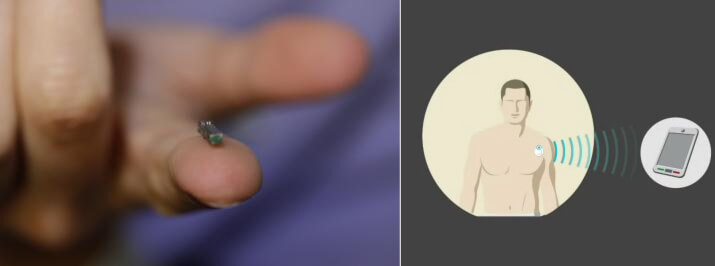
Credit: EPFL
The world's first HIV vaccine is commercially available
HIV/AIDS was first characterised in 1983. By the early 2010s, the virus had killed over 35 million people globally and another 34 million were living with the infection. Although a cure remained elusive, antiretroviral treatments were able to slow the progression of the disease and provide sufferers with a near-normal life expectancy. However, while antiretroviral treatments reduced the risk of death, these medications were expensive and often associated with side effects.
In 2012, a vaccine known as SAV001 – which had previous success in animal subjects – began Phase 1 human clinical trials in Canada. This randomised, observer-blinded, placebo-controlled study used a ground-breaking technique involving a genetically modified, killed whole-virus vaccine. Prior to this, other experimental vaccines had either used subunits of the virus, or relied on genetically modified non-HIV viruses to carry an HIV-like genetic sequence.
SAV001 was administered to infected men and women aged 18 to 50. Results from the trials showed that patients experienced no adverse effects – no local reactions from the injections, or any signs, symptoms, or reactions to any potential toxicities – while significantly boosting immunity.*
With proven safety and tolerability in humans, the experimental vaccine progressed to Phase II and Phase III trials, with similar success. By 2017, it is becoming commercially available.*
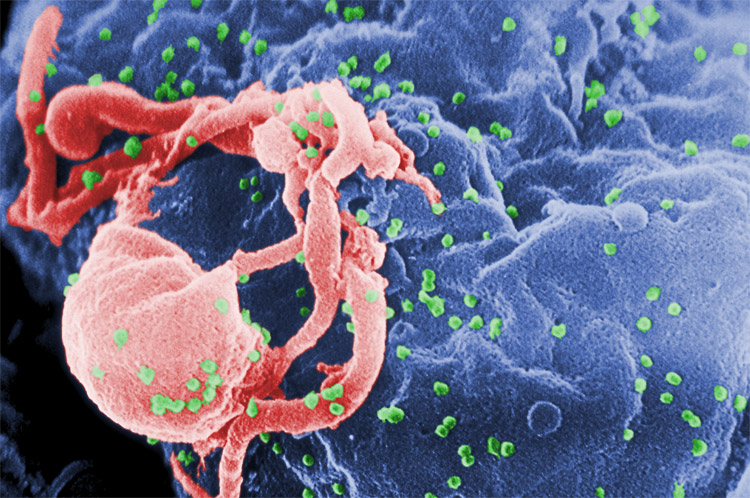
A new treatment for prostate cancer
Prostate cancer is a form of cancer that develops in the prostate, a gland in the male reproductive system. It can cause pain, difficulty in urinating, problems during sexual intercourse, or erectile dysfunction. It can also metastasize (spread) from the prostate to other parts of the body, particularly the bones and lymph nodes. Globally, it is the sixth leading cause of cancer-related death in men (in the USA it is the second). It tends to develop in men over the age of 50 and is most common in the developed world.
In 2012, a study was conducted on a potential new treatment. This used High-Intensity Focused Ultrasound (HIFU) to vibrate tissues the size of a grain of rice, heating them to about 80-90°C (176-194°F). This effectively killed the cancerous cells, in a highly localised area without damage to neighbouring healthy tissues. Because of the beam's extreme precision, there were few reported side effects. Although one in ten were left impotent, this was far less than traditional treatment methods, and none of the volunteers were left incontinent. 95% of study participants were free of cancer after 12 months.
A larger trial was conducted, with similar success. By 2017, the treatment is offered routinely on the NHS* and in many other countries, leading to a marked improvement in survival rates and patient comfort. The procedure is fast and most patients are back home within 24 hours.*
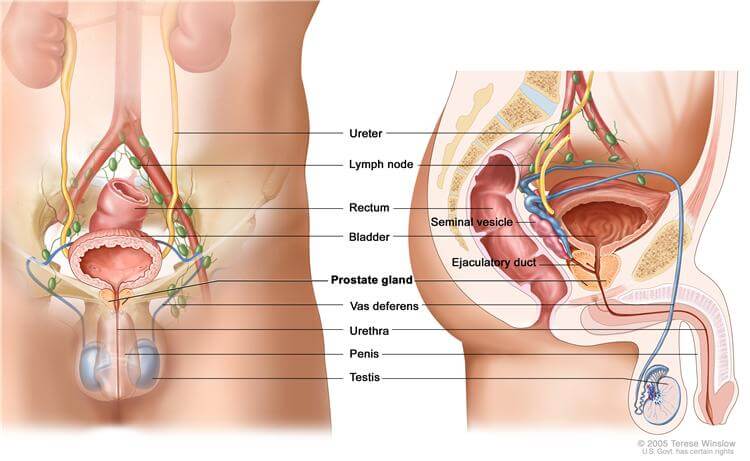
BioCassava Plus receives regulatory approval
Cassava is a root vegetable, high in carbohydrates, that forms a major staple food in the developing world, providing a basic diet for over half a billion people. It is among the most drought-tolerant crops, able to grow on marginal soils.
However, this vegetable has a number of downsides. With toxins including cyanide, improper preparation can lead to acute intoxication and goiters, or even ataxia and paralysis. It is also a poor source of protein and may cause protein-energy malnutrition, unless consumed as part of a more balanced and varied diet. Two diseases – Cassava Mosaic Disease (affecting the edible leaves) and Brown Streak Disease (which rots and kills the roots) – have caused devastating famines in the past. The latter is especially troublesome in coastal East Africa and around the eastern lakes, where it is the single biggest threat to food security. In addition, cassava has a poor shelf life of only two to three days.
In 2003, Bill Gates announced the "Grand Challenges in Global Health", a $200m effort to address healthcare and extreme poverty in the developing world. The following year, his charity – the Bill & Melinda Gates Foundation – selected BioCassava Plus, a biotechnology project to improve cassava. With genetic engineering and a range of crop breeding techniques, it would be possible to enrich the protein content, reduce the vegetable's toxicity, fortify it with vitamins A and E, iron and zinc, make it resistant to viruses and extend its shelf life ten-fold.
After more than a decade of research and development, the project would obtain regulatory approval in 2017,* radically improving the health of many millions of people. Although generating controversy, genetic engineering remains a safe and effective method in food, with no cases of illness from over a trillion meals served.*
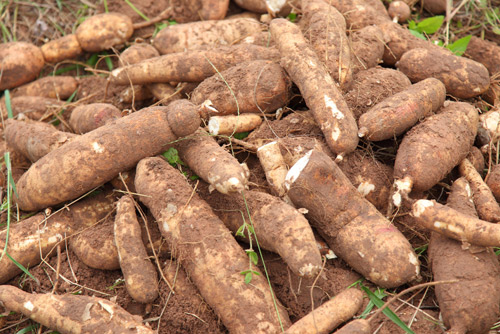
The world's largest mud volcano stops erupting
The Sidoarjo mud flow, commonly known as Lusi, was a continuous flow of water, steam and mud erupting in Sidoarjo, a sub-district of Porong in East Java, Indonesia. The mud flow began in May 2006, after a blowout in a drilling well caused by pressurised natural gas and carbonated water. Although most of the blame was put on the company involved in the drilling, they themselves claimed that a 6.3 magnitude quake had triggered the eruption a few days earlier.
At its peak, Lusi flowed at 180,000m³ per day – destroying homes, businesses and schools, and by 2011 had left over 13,000 people homeless. Many suffered severe burns as a result of the hot mud and steam. The flow had originally been expected to last until the 2030s,* but in subsequent years it began to destabilise and form a caldera around the original drilling well. By 2017 it has finally subsided.*
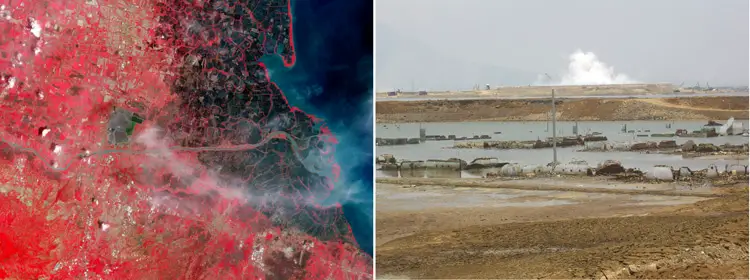
Credit: NASA / Hugh e82 (CC BY-SA 3.0)
Các bài viết khác
- 2016 timeline contents (03.12.2015)
- Hồ sơ mật Những người kiến tạo nước Mỹ Phần 1 (13.11.2015)
- MiG 35 Russia's Answer to the F 35 (13.11.2015)
- Sống để làm gì - TT. Thích Chân Quang (13.11.2015)
- Tổng hợp vũ khí hiện đại Việt Nam đã nhận 2015 (13.11.2015)
- Tu 160 ' White Swan '! Wings of Russia (13.11.2015)
- Video việc Trung Quốc đang xâm chiếm và xây dựng trái phép ở Biển Đông phần 2 (13.11.2015)
- VTC14 Tìm thấy dấu vết mới của sự sống trên sao Hỏa (13.11.2015)
- White swan TU 160 (13.11.2015)
- Wings of Russia. MiG-25 and MiG-31. Best In Class (1 of 2) (13.11.2015)
- Why Quantum Physics Ends the Free Will Debate (13.11.2015)
- Welcome to the 2030s Future Timeline Events 2030 2039 (13.11.2015)
- Welcome to the 2020s Future Timeline Events 2020 2029 (13.11.2015)
- Những hình ảnh từ Sao Hỏa khiến thế giới phải kinh hoàng (13.11.2015)
- Sáng chế robot thay con người làm việc nhàm chán, nguy hiểm (13.11.2015)
- Phỏng vấn Chủ tịch Hiệp hội Thủy sản Mỹ Nguồn VTV (13.11.2015)
- Robot vận tải của Thủy quân lục chiến Mỹ (13.11.2015)
- Xi Jinping: A 21st-century Mao? (13.11.2015)
- Worst Idea Ever: Dropping Nuclear Bombs During the Vietnam War (13.11.2015)
- Will South China Sea Dispute Lead to World War? (13.11.2015)
- Why the United States and Vietnam Urgently Need to Deepen Ties (13.11.2015)
- Why NAFTA passed and the Trans-Pacific Partnership failed (13.11.2015)
- What it will take for a head transplant to work (13.11.2015)
- What is civic capitalism? An interview with Colin Hay (13.11.2015)
- What China dangerously underestimates about America's interest in the South China Sea (13.11.2015)
- What Caused capitalism? (13.11.2015)
- Weaponized The "China Card" Makes Its Return to U.S. Politics (13.11.2015)
- We have heard that the Secretary General of the Vietnam Communist Party (13.11.2015)
- Vladimir Putin 2015 (13.11.2015)
- Vietnam Muddles China's South China Sea Challenge (13.11.2015)
- Vietnam 40 Years Later (13.11.2015)
- Việt Nam đang ngồi nhìn? (13.11.2015)
- Với TPP Việt Nam sẽ trở thành cường quốc hàng hải 2030 (13.11.2015)
- Vì sao căn hộ nhỏ ở đô thị đang là mốt? (13.11.2015)
- U.S. to Vietnam: Stop Hosting Putin’s Jets Please (13.11.2015)
- US to Press China on Island Expansions (13.11.2015)
- Turf wars Vietnam s land rights crisis (13.11.2015)
- Tuổi Già Hải Ngoại Và Niềm Vui Internet (13.11.2015)
- TƯ BẢN Thế kỷ XXI (13.11.2015)
- Trung Xô luận chiến công khai (13.11.2015)
- Trung Quốc cưỡng chiếm trái phép Hoàng Sa (13.11.2015)
- Vị thế của Mỹ đang bị thách thức (12.11.2015)
- Tranh giành Quyền lực và Hòa giải Dân tộc (12.11.2015)
- TPHCM: Nguồn cung căn hộ tăng mạnh trong quý 3/2015 (12.11.2015)
- Tinh dầu thông đỏ chữa ung thư: Thần dược hay lừa đảo (12.11.2015)
- Tiền vẫn đổ vào bất động sản Hà Nội (12.11.2015)
- Thời sự và suy ngẫm, số 97 (12.11.2015)
- Thế nào là tướng có phúc khí? (12.11.2015)
- The Bloodthirsty Deng We Didn’t Know (10.11.2015)
- Tình hình 2011 và Ba kịch bản cho thị trường bất động sản đến cuối năm (10.11.2015)
- SECRETARY KISSINGER (10.11.2015)
- PHỐ ĐÔNG VILLAGE BIỆT THỰ, NHÀ PHỐ TỐT NHẤT TP. HCM, KĐT (10.11.2015)
- TPHCM khai thác nhà xưởng cao tầng đầu tiên (10.11.2015)
- Ông chủ Sơn Kim Land: Kinh doanh căn hộ cao cấp cũng giống như ngành thời trang (10.11.2015)
- Áo dài người Việt (09.11.2015)
- Chủ tịch vương triều Tập có những điểm yếu của mình (09.11.2015)
- Những thế cờ Hoa Kỳ - Trung quốc (09.11.2015)
- Nhật đang đổ bộ đầu tư vào bất động sản Việt Nam (09.11.2015)
- NGƯỜI MÊ PHỞ NÓI CHUYỆN PHỞ...! (09.11.2015)
- Ngập lụt đô thị - phải làm gì bây giờ? (09.11.2015)
- Năm năm nhìn lại chuyên đề tiền tệ 2011 (09.11.2015)
- Doanh nghiệp bất động sản như ngồi trên lửa (09.11.2015)
- Mỹ so với Trung Quốc: Chiến tranh là không thể tránh khỏi, chỉ cần? (09.11.2015)
- MÙA ĐÔNG ĐẾN SỚM VÀ NHẬT BẢN VỀ ĐÊM (09.11.2015)
- MUA BÁN NHÀ KHÔNG THÀNH XỬ LÍ RA SAO? (09.11.2015)
- 'Khó thay đổi lớn về chính trị ở VN' (09.11.2015)
- Hiểm họa Trung Quốc và bài học từ Tiệp Khắc, Ukraina (09.11.2015)
- Giá bất động sản - sự phi lý trong cái hợp lý (09.11.2015)
- Giá bán căn hộ tại TPHCM và Hà Nội quý 4/2015 vẫn khó (09.11.2015)
- Về giải quyết tranh chấp, khiếu nại, tố cáo về đất đai (09.11.2015)
- Dự báo 20 năm ( 2014-2034) (09.11.2015)
- Dự án Đảo Kim Cương đã bán được hơn 60% căn hộ (09.11.2015)
- Doanh nghiệp bất động sản như ngồi trên lửa (09.11.2015)
- Col Liu Mingfu on the U.S. and China as Rivals (09.11.2015)
- Chuẩn bị chiến tranh với Trung Quốc (09.11.2015)
- Chủ quyền Hoàng Sa – Trường Sa? (09.11.2015)
- Chủ nghĩa tư bản và khủng hoảng tài chánh toàn cầu Vietsciences- Nguyễn Trường (09.11.2015)
- China Stands by Its Claims Over South China Sea Reefs (09.11.2015)
- China’s South China Sea strategy: simply brilliant (09.11.2015)
- Can China Be Contained? (09.11.2015)
- Bong bóng bất động sản rất dễ xảy ra? (09.11.2015)
- Bill Gates: Nếu bạn nghĩ giáo viên của mình quá khó tính, bạn sẽ gặp trở ngại với cấp trên sau này (09.11.2015)
- BĐS dành cho nhà giàu bước vào cuộc đua mới (09.11.2015)
- Bào Chữa Vụ Án Lập quỹ trái phép phép tại Nông trường Sông Hậu (09.11.2015)
- Bài thuốc Minh Mạng thang gồm 22 vị (09.11.2015)
- Bài thuốc chống suy nhược từ linh chi (09.11.2015)
- Ảo Vọng Mùa Thu (09.11.2015)
- 2014Thị trường bất động sản đã trải qua nhiều thăng trầm (09.11.2015)
- 16 trường đại học đẹp nhất trên thế giới (09.11.2015)
- 7 tuần lễ sau khi thành đạo (08.11.2015)
- Chuyên đề Mỹ áp sát các đảo cát do Trung Quốc xây bất hợp pháp ở Biển Đông (28.10.2015)
- AFTER THE FALL OF SAIGON (27.10.2015)
- What Caused Capitalism? (27.10.2015)
- Cơ Hội Lớn Cho “Bánh Mì” Việt Nam (25.10.2015)
- HỒI KÝ TỪ TUỔI NGỦ THẬP ĐẾN THẤT THẬP CỦA PHẬT TỬ NGUYỄN KIM TOÀN (24.10.2015)
- Nhật Bản - Đất nước - Con người (08.10.2015)
- Nhạc không lời êm đềm du dương hay nhất sốt mọi thời đại Toinoi com (08.10.2015)
- Westlife When You Tell Me That You Love Me Wit (08.10.2015)
- Rachael Yamagata Over And Over Lyrics (08.10.2015)
- Over and Over Nana Mouskouri lyrics (08.10.2015)
- HD Chuc Xuan Ban AVT (08.10.2015)
- Nana Mouskouri Love Story (08.10.2015)
- John Legend - Tonight (Best You Ever Had) feat. Ludacris (08.10.2015)
- 1000 cụm từ tiếng anh thông dụng nhất hay sử dụng hàng ngày full (08.10.2015)
- LOVE STORY With Lyrics = ENGELBERT HUMPERDINCK (08.10.2015)
- LOVE STORY Where Do I Begin Andy Williams Ly (08.10.2015)
- Liệu có xảy ra xung đột quân sự ở Biển Đông (08.10.2015)
- Andy Williams, 20 Greatest Songs Hits with Lyrics 1 of 2 (08.10.2015)
- Full 5 Bước Để Nói Một Ngoại Ngữ YouTube (08.10.2015)
- Elton John SACRIFICE Lyrics HQ (08.10.2015)
- Ban kích động nhạc Số Dzách & AVT Thập niên 60 (08.10.2015)
- Creed My Sacrifice With Lyrics (08.10.2015)
- Ban AVT Chúc tết hải ngoại Clip giải trí hài kị (08.10.2015)
- Amazing Grace Best Version By Far! (08.10.2015)
- Amazing Grace Lyrics (08.10.2015)
- { Nana Mouskouri } Love Story (08.10.2015)
- 27 năm sự kiện Trung Quốc tấn chiếm Gạc Ma (08.10.2015)
- Hồ sơ mật Những người kiến tạo nước Mỹ Phần 1 (08.10.2015)
- Học qua bài hát (08.10.2015)
- Phát âm tiếng anh - Mr Kenny Ng (08.10.2015)
- Quan hệ Việt-Mỹ và thế cân bằng trong quan hệ với các siêu cường (08.10.2015)
- QUY HOẠCH SÀI GÒN TRƯỚC 1975 DƯỚI ẢNH HƯỞNG CỦA HOA KỲ (08.10.2015)
- Quyền lực dầu đá phiến Mỹ: Đòn khí đốt Nga vô hiệu (08.10.2015)
- Rối loạn kinh tế TQ và ảnh hưởng tới VN (08.10.2015)
- Sáu vấn đề đằng sau vụ chứng khoán TQ (08.10.2015)
- Tập Cận Bình (08.10.2015)
- Tham vọng quyền lực và sự tha hóa (08.10.2015)
- Thế chiến II: trại tù kinh hoàng của quân Nhật (08.10.2015)
- Thế giới không còn phẳng nữa rồi? (08.10.2015)
- Thế lưỡng nan của Hoàng đế Tập Cận Bình (08.10.2015)
- Lần theo dấu chân Người trên đất Mỹ - Bài 3: Bác Hồ ở Boston (08.10.2015)
- THUYẾT "LÃNH ĐẠO TỪ PHÍA SAU" HAY TRÒ "XUỴT CHÓ BỤI RẬM" (08.10.2015)
- Tìm lối ra cho kinh tế Việt Nam - Kỳ 12: Tái cơ cấu một cách đồng bộ (08.10.2015)
- Toàn văn chiến lược quân sự mới của Mỹ (08.10.2015)
- Tôi thực sự choáng trước dự thảo ‘sặc mùi Mỹ’ (08.10.2015)
- Tỷ phú số một Hồng Kông lặng lẽ rút khỏi Trung Quốc (08.10.2015)
- Vấn nạn Giáo dục Nguyên nhân và Hậu quả - Nguyễn Quang Dy (08.10.2015)
- (08.10.2015)
- Những điều lạ trong dự báo thế giới 100 năm tới - NGUYỄN HẢI HOÀNH (08.10.2015)
- Nhật Bản: ‘Thuế ở VN phức tạp, mất thì giờ’ (08.10.2015)
- Người dựng kỳ đài Ngày Độc lập 2/9 (08.10.2015)
- Nắm hàng triệu ha đất, nộp ngân sách không bằng một nhà máy (08.10.2015)
- Mỹ-Hoa và chiến lược dài hạn tại Thái Bình Dương (08.10.2015)
- Một số vấn đề kinh tế Trung Quốc đang đối mặt (08.10.2015)
- Li Ka Shing, tỷ phú "siêu nhân" (08.10.2015)
- Lá thư viết vào năm 2070... (08.10.2015)
- Lá thư để lại giữa rừng (08.10.2015)
- Kinh tế TQ qua các con số chóng mặt (08.10.2015)
- Hệ thống tài chính Việt Nam bị đánh giá rủi ro ở mức (08.10.2015)
- Hai mươi năm bức thư của cố Thủ tướng Võ văn Kiệt (08.10.2015)
- ĐỪNG CÓ DẠI, ĐẢNG CSVN KHÔNG QUÊN "CHUYÊN CHÍNH VÔ SẢN" ĐÂU. (08.10.2015)
- Ðời là bể khổ....Qua được bể khổ... là qua đời ! (08.10.2015)
- ĐỌC LẠI HỒI KÝ TRẦN QUANG CƠ (08.10.2015)
- Định nghĩa mới về kinh tế thị trường XHCN (08.10.2015)
- Diễn Văn Của Đức Giáo Hoàng Phanxicô tại Bolivia với Các Phong Trào Bình Dân (08.10.2015)
- Đảng CS lấy ý kiến về báo cáo chính trị (08.10.2015)
- Vấn nạn lớn nhất của Obama trong việc thúc đẩy TPP (08.10.2015)
- Việt Nam có thể trở thành một trong cửu bá trong thế giới đa cực vào năm 2025 (08.10.2015)
- Hệ thống ngân hàng (08.10.2015)
- The root of China's economic troubles? It's politics, stupid (08.10.2015)
- The Meaning of Kissinger (08.10.2015)
- henry Kissinger was 26 years old when he wrote a nearly 400 (08.10.2015)
- Interview With Chinese President Xi Jinping WALL STREET JOURNAL (08.10.2015)
- Đại sứ Lê Văn Bàng: Sự tham gia của Nhật sẽ tạo thế cân bằng ở Biển Đông (08.10.2015)
- Có hay không sự tồn tại của 'vùng cấm chính trị'? (08.10.2015)
- China’s risky money game (08.10.2015)
- Cải cách kinh tế thúc đẩy thay đổi thể chế (08.10.2015)
- Bức tranh toàn diện về xử lý nợ xấu ngân hàng từ 2010 đến tháng 8/2015 (08.10.2015)
- Báo cáo 2035: VN bị thách thức về kinh tế, dồn ép về xã hội (08.10.2015)
- Bài học dạy con làm nức lòng dân mạng của MC Nguyễn Cao Kỳ Duyên (08.10.2015)
- Dreams of Empire - PETER BERGER (08.10.2015)
- Việt nam trở thành công xưởng sản xuất khổng lồ của thế giới (08.10.2015)
- CURRENT HISTORY • September 2015 (08.10.2015)
- Bác Hồ đã chọn đúng những vị trí lãnh đạo (08.10.2015)
- Ba lý do khiến FED giữ nguyên lãi suất (08.10.2015)
- 2015.09-Gerwin_TPP-and-the-Benefits-of-Freer-Trade-for-Vietnam (08.10.2015)
- 16 trường đại học đẹp nhất trên thế giới (08.10.2015)
- 9 thứ người giàu nghĩ và hành động khác người nghèo (08.10.2015)
- 8 năm gia nhập WTO: “Nghịch lý” và “lỗi hệ thống” (08.10.2015)
- ASEAN must choose between China, US and a third way (08.10.2015)
- Pentagon Papers (08.10.2015)
- KHỦNG HOẢNG TÀI CHÍNH TOÀN CẦU VÀ NHỮNG TÁC ĐỘNG ĐẾN VIỆT NAM: NHÌN TỪ GÓC ĐỘ NGÂN HÀNG VÀ CHỨNG KHOÁN (08.10.2015)
- “Mua” và “mượn” nhân lực ra sao? (08.10.2015)
- Vietnam defies emerging market slowdown (08.10.2015)
- Vietnams rising repression (08.10.2015)
- Ba trong số những hòn đảo là điểm đến được dân du lịch trẻ nhắc nhiều nhất trong năm nay phải kể đến đảo Lý Sơn (08.10.2015)
- Cận cảnh nơi an nghỉ của đại gia giàu nhất Sài Gòn xưa bên trong nhà thờ Huyện Sĩ (08.10.2015)
- Không để tiền lại cho con (08.10.2015)
- VE VÀ KIẾN (08.10.2015)
- Lá thư viết vào năm 2070... (08.10.2015)
- Người mang bí số TQ2 (08.10.2015)
- Những tấm ảnh để đời chụp những ngày Sài Gòn giải phóng (08.10.2015)
- Làm kinh tế theo lời Phật dạy (08.10.2015)
- Samurai: Một thời kiếm sỹ huyền thoại (08.10.2015)
- Tài tử, giai nhân ngày ấy bây giờ - NSƯT Nguyễn Chánh Tín bán nước đóng chai, mở quán nhậu sống qua ngày (08.10.2015)
- Trịnh Công Sơn tiên cảm về hòa bình, hòa giải và tự do (08.10.2015)
- Về hưu như chết lâm sàng (08.10.2015)
- Vũ trụ sẽ diệt vong như thế nào? (08.10.2015)
- Bài bào chữa Phúc Thẩm (08.10.2015)
- BAI BIEN MINH GỞI VIỆN KS TỐI CAO (08.10.2015)
- Bài biên minh vụ án sản xuất làm giả phân bón gởi bo trưởng bộ congan (08.10.2015)
- Các Quyết định giám đốc thẩm về các tranh chấp liên quan đến thừa kế (08.10.2015)
- CHUYÊN ĐỀ Biện pháp khẩn cấp tạm thời trong tố tụng dân sự (08.10.2015)
- Đề cương bài giảng Luật Tố tụng hình sự (08.10.2015)
- Đơn khiếu này vụ án Tân Uyên (08.10.2015)
- Đơn khiếu nại Phan Thị Trước gửi ỦY BAN NHÂN DÂN THỊ TRẤN TẦM VU (08.10.2015)
- Đơn Kiến nghị Giám đốc Thẩm vụ án dân sự Vicẩm Tú -seoun Tai bai (08.10.2015)
- Đơn khởi kiện Chia di sản long an (08.10.2015)
- Luật đứng về phía con nợ chây ì (08.10.2015)
- Lực lượng thực thi pháp luật chưa nghiêm, tăng mức phạt giải quyết được gì? (08.10.2015)
- 10 loại cây hút khí độc trong nhà cực tốt (08.10.2015)
- Cập nhật phương pháp điều trị suy thận mạn tính (08.10.2015)
- Chữa suy tim (08.10.2015)
- Dược thiện dành cho người bị thiếu máu (08.10.2015)
- Cựu Tổng thống Mỹ Jimmy Carter bị ung thư (08.10.2015)
- Đau nửa đầu bên trái, dấu hiệu bệnh gì? (08.10.2015)
- Điều trị thiếu máu do suy thận mạn thế nào (08.10.2015)
- Dù đã bước vào tuổi 100 (08.10.2015)
- Ghép tế bào gốc cuộc cách mạng” trong điều trị bệnh lý về máu (08.10.2015)
- Già Sao Cho Sướng! (08.10.2015)
- Những điều cần biết về bệnh suy tủy (08.10.2015)
- Khi bạn qua tuổi 65, hãy hưởng thụ những gì mình yêu thích… (08.10.2015)
- Nhiều người Mỹ không muốn sống hơn 100 tuổi (08.10.2015)
- Thang Thuốc Trường Thọ từ dân gian Trung Hoa (08.10.2015)
- THIẾU MÁU (08.10.2015)
- Thủ tướng Singapore bàn về Biển Đông tại trường đảng của Trung Quốc (08.10.2015)
- Việt Nam cần học gì từ quân sự Nhật? (08.10.2015)
- Will China crash? (08.10.2015)
- The Truth About US Freedom of Navigation Patrols in the South China Sea (08.10.2015)
- Tàu sân bay Mỹ sắp hết thời ? (08.10.2015)
- Nhật sẽ cấp thêm tàu cho Việt Nam (08.10.2015)
- Ngày này tháng 1/ 1974: Kissinger và vụ Hoàng Sa! (08.10.2015)
- China's Meltdown Goes Deeper Than the Stock Market (08.10.2015)
- China's FakeIslands in the South China Sea: What Should America Do? (08.10.2015)
- BÀI VIẾT PHÂN TÍCH Chiến tranh với Trung Quốc (08.10.2015)
- ASEAN must choose between China, US and a third way (08.10.2015)
- 10 lý do khiến Trung Quốc gặp khó khăn trong chiến tranh hiện đại (08.10.2015)
- Thủ Thiêm gần hết đất để phát triển khu dân cư (08.10.2015)
- Sức sống của cát (08.10.2015)
- Trung Quốc: “Bệnh đô thị” ngày càng lây lan (08.10.2015)
- Dự Đoán Địa ốc 2007-2015 (08.10.2015)
- Doanh nghiệp bất động sản Tp Hồ Chí Minh (08.10.2015)
- Chuyên đề tiền vào bất động sản 2015 (08.10.2015)
- Chuyên đề Bất động sản 2015 bắt đầu cho đợt sóng lớn năm năm bền vững ?!!! (08.10.2015)
- ‘Của để đời’ của những đại gia lạ trong giới BĐS (08.10.2015)
- Già ơi, Chào Mi! (04.09.2015)
- Làm thế nào để giảm nguy cơ tai biến mạch máu não ở phụ nữ (04.09.2015)
- Những cái cũ & xưa nhất của Saigon (27.08.2015)
- Nguyên Nhân Thành Công Của Những Người gốc Do Thái ??? (27.08.2015)
- HÌNH ẢNH SAIGON qua máy ảnh người nước ngoài (27.08.2015)
- Một khúc ca xuân! (Tố Hữu) (27.08.2015)
- 10 câu hỏi dành cho nhà vật lý lỗi lạc nhất hiện nay, Stephen Hawking (27.08.2015)
- Bí ẩn tuyệt tự của 3 đời vua cuối cùng nhà Thanh (27.08.2015)
- TRỜI PHẬT DẠY VỀ THỜI GIAN - NGHIỆP BÁO (27.08.2015)
- ĐẮNG VÀ NGỌT (27.08.2015)
- Thư giãn với những hình ảnh đẹp của thiên nhiên (27.08.2015)
- Bài thơ Vấn thoại của Hồ Chí Minh và vụ án oan của ông Nguyễn Thanh Chấn – trandinhsu P2 (27.08.2015)
- Vui trồng hoa thay vì buồn nhổ cỏ (27.08.2015)
- Khám phá Ðèo Ngang (27.08.2015)
- Bài thơ : “Vội” (27.08.2015)
- A Tribute to the Dog - bài diễn văn bất hủ ngợi ca con chó (27.08.2015)
- Cõi già trên Đất Lạ (27.08.2015)
- Thiền và kinh tế học "Thủy tự mang mang hoa tự hồng (27.08.2015)
- Cha con cạn tình (27.08.2015)
- Cha, con và miếng đất (27.08.2015)
- trước cau sau chuối (27.08.2015)
- Điên Vì Đàn Bà (27.08.2015)
- Anh xin thề (27.08.2015)
- Ai ? (27.08.2015)
- Phút thật lòng (27.08.2015)
- Vợ nghĩ gì về chồng (27.08.2015)
- Thời @ (27.08.2015)
- Ba con quỷ (27.08.2015)
- Đỉnh cao đối đáp (27.08.2015)
- Trung Quốc và thế giới (27.08.2015)
- Trung Quốc trắng trợn lộ kế hoạch đánh chiếm đảo thuộc Trường Sa năm 2014 (27.08.2015)
- Thẩm định về ” Thế Kỷ Trung Quốc ?” (27.08.2015)
- Mỹ đang giữ liên lạc chặt chẽ với Việt Nam về vụ giàn khoan Trung Quốc (27.08.2015)
- Mỹ: Trung Quốc phải làm rõ tuyên bố chủ quyền Biển Đông theo UNCLOS (27.08.2015)
- Liệu có xảy ra chiến tranh tại Biển Đông? (27.08.2015)
- Kiện TQ, cơ hội thắng của Việt Nam đến đâu? (27.08.2015)
- Kiềm chế, đối thoại và tuân thủ luật pháp quốc tế (27.08.2015)
- Giàn khoan Hải Dương 981 vướng núi đá ngầm Việt Nam (27.08.2015)
- Giàn khoan Hải Dương 981 “vào giai đoạn hai” (27.08.2015)
- Giải mã tín hiệu chiến tranh của Trung Quốc - Kỳ 3 (27.08.2015)
- ĐÃ ĐẾN LÚC VIỆT NAM PHẢI QUYẾT ĐỊNH! (27.08.2015)
- Biển Đông: Thế trận mới đang hình thành (27.08.2015)
- Đương đầu với thách thức từ Trung Quốc (27.08.2015)
- Đội Hoàng Sa và bí mật quân lương (27.08.2015)
- Bộ trưởng Quốc phòng Việt Nam, Đại tướng Phùng Quang Thanh, vừa có chuyến thăm chính thức Hoa Kỳ. (27.08.2015)
- Mạ Lê Thị A (27.08.2015)
- 49 điều cha dạy con 2014 (27.08.2015)
- Bà mẹ Việt Nam (27.08.2015)
- Nhật ký ông Nội phần 3 (27.08.2015)
- Hồi ký Ông nội -phần 2 (27.08.2015)
- Hồi ký Ông nội -phần 1 (27.08.2015)
- Bình luận khoa học hình sự tập 10 (27.08.2015)
- Bình luận khoa học hình sự tập 9 (27.08.2015)
- Bình luận khoa học hình sự tập 8 (27.08.2015)
- Bình luận khoa học hình sự tập 6 (27.08.2015)
- Bình luận khoa học hình sự tập 5 (27.08.2015)
- Bình luận khoa học hình sự tập 4 (27.08.2015)
- Bình luận khoa học hình sự tập 3 (27.08.2015)
- Bình luận khoa học hình sự tập 2 (27.08.2015)
- Bình luận khoa học hình sự tập 1 (27.08.2015)
- Bình luận khoa học hình sự tập 1 (26.08.2015)
- Luật dân sự 2005 (26.08.2015)
- Đơn khởi kiện đòi nợ vay (26.08.2015)
- ĐƠN YÊU CẦU GIẢI QUYẾT KHIẾU NẠI (26.08.2015)
- Bàn về xác minh điều kiện thi hành án (26.08.2015)
- Nghị Định 84-2007-CP giấy quyền SD đất (26.08.2015)
- Nghị Định 84-2007-CP giấy quyền SD đất (26.08.2015)
- GIẢI QUYẾT CÁC TRANH CHẤP LIÊN QUAN ĐẾN QUYỀN SỬ DỤNG ĐẤT TẠI TOÀ ÁN NHÂN DÂN (26.08.2015)
- THÔNG TƯ 70 BỘ CÔNG AN QUY ĐỊNH CHI TIẾT THI HÀNH CÁC QUY ĐỊNH CỦA BỘ LUẬT TỐ TỤNG HÌNH SỰ LIÊN QUAN ĐẾN VIỆC BẢO ĐẢM QUYỀN BÀO CHỮA TRONG GIAI ĐOẠN ĐIỀU TRA VỤ ÁN HÌNH SỰ (26.08.2015)
- Nghị định xử phạt hành chính trong lĩnh vực tư pháp có hiệu lực từ ngày 18-9: (26.08.2015)
- Nghị quyết của Hội đồng Thẩm phán Tòa án nhân dân tối cao số 02/2004/QĐ-HĐTP ngày 10-8-2004 hướng dẫn áp dụng pháp luật trong việc giải quyết các vụ án dân sự, hôn nhân và gia đình (26.08.2015)
- Luật Thương mại 2005 (26.08.2015)
- Luật Doanh Nghiệp năm 2005 (26.08.2015)
- Nghị Định 14/2007/NĐ-CP (26.08.2015)
- Luật quy định về hoạt động chào bán chứng khoán ra công chúng, niêm yết, giao dịch, kinh doanh, đầu tư chứng khoán, dịch vụ về chứng khoán và thị trường chứng khoán. (26.08.2015)
- luật dân sự (26.08.2015)
- NGHỊ ĐỊNH 121/2007/NĐ-CP (26.08.2015)
- THÔNG TƯ 59/2007/TT-BTC (26.08.2015)
- THÔNG TƯ 61/2007/TT-BTC (26.08.2015)
- NGHỊ ĐỊNH 35/2006/NĐ-CP (26.08.2015)
- NGHỊ ĐỊNH 59/2006/NĐ-CP (26.08.2015)
- NGHỊ ĐỊNH 158/2006/NĐ-CP (26.08.2015)
- NGHỊ ĐỊNH 52/2006/NĐ-CP (26.08.2015)
- THÔNG TƯ 09/2007/TT-BTM (26.08.2015)
- LUẬT NGƯỜI LAO ĐỘNG VIỆT NAM ĐI LÀM VIỆC Ở NƯỚC NGOÀI THEO HỢP ĐỒNG (26.08.2015)
- LUẬT SỬA ĐỔI, BỔ SUNG MỘT SỐ ĐIỀU CỦA BỘ LUẬT LAO ĐỘNG (26.08.2015)
- NGHỊ ĐỊNH 133/2007/NĐ-CP (26.08.2015)
- THÔNG TƯ 38/2007/TT-BTCTHÔNG TƯ 17/2007/TT-BTC (26.08.2015)
- NGHỊ ĐỊNH 140/2007/NĐ-CPNGHỊ ĐỊNH 139/2007/NĐ-CP (26.08.2015)
- Quy trình cấp giấy phép xây dựng (26.08.2015)
- NGHỊ QUYẾT 48/2007CP-NĐ (26.08.2015)
- BỘ LUẬT DÂN SỰ (26.08.2015)
- Quy định chi tiết thi hành các quy định của Bộ luật dân sự (26.08.2015)
- NGHỊ ĐỊNH 126/2007/NĐ-CP (26.08.2015)
- THÔNG TƯ 17/2007/TT-BTC (26.08.2015)
- THÔNG TƯ 38/2007/TT-BTC (26.08.2015)
- PHÁP LỆNH THỪA KẾ (26.08.2015)
- NGHỊ ĐỊNH 139/2007/NĐ-CP (26.08.2015)
- NGHỊ ĐỊNH 140/2007/NĐ-CP (26.08.2015)
- Quy trình cấp giấy phép xây dựng (26.08.2015)
- NGHỊ QUYẾT 48/2007CP-NĐ (26.08.2015)
- BỘ LUẬT DÂN SỰ (26.08.2015)
- Quy định chi tiết thi hành các quy định của Bộ luật dân sự (26.08.2015)
- Quy định chi tiết thi hành Luật Thuế thu nhập doanh nghiệp (26.08.2015)
- Quy định chi tiết thi hành một số điều của Luật Quản lý thuế (26.08.2015)
- LUẬT KINH DOANH BẤT ĐỘNG SẢN (26.08.2015)
- THONG TU 59 NAM 2004 (26.08.2015)
- NGHI DINH 100 NAM 2006 (26.08.2015)
- Luật Sở Hữu Trí Tuệ (26.08.2015)
- NGHI DINH 70 NÁM997 (26.08.2015)
- NGHI DINH 142 NAM 2005 (26.08.2015)
- QUYẾT ĐỊNH 54 NĂM 2007 (26.08.2015)
- NGHI DINH 123 NAM 2007 (26.08.2015)
- NGHI DINH 90 NAM 2006 (26.08.2015)
- NGHI DINH 84 NAM 2007 (26.08.2015)
- luật đất đai (26.08.2015)
- LUẬT CƯ TRÚ (26.08.2015)
- LUẬT QUẢN LÝ THUẾ (26.08.2015)
- NGHỊ ĐỊNH CỦA CHÍNH PHỦ SỐ 103/2006/NĐ-CP NGÀY 22 THÁNG 9 NĂM 2006 (26.08.2015)
- NGHỊ ĐỊNH CỦA CHÍNH PHỦ SỐ 36/2007/NĐ-CP NGÀY 08 THÁNG 3 NĂM 2007 VỀ XỬ PHẠT VI PHẠM HÀNH CHÍNH TRONG LĨNH VỰC CHỨNG KHOÁN (26.08.2015)
- NGHỊ ĐỊNH 163/2006/NĐ-CP ngày 29 tháng 12 năm 2006 quy dịnh về đăng ký giao dịch bảo đảm. (26.08.2015)
- những câu hỏi thường gặp (26.08.2015)
- Cấp thẻ APEC cho doanh nhân VN (26.08.2015)
- CỘNG HOÀ XÃ HỘI CHỦ NGHĨA VIỆT NAM Độc lập - Tự do - Hạnh phúc ------------------------- GIẤY ĐỀ NGHỊ ĐĂNG KÝ KINH DOANH CÔNG TY HỢP DANH Kính gửi: Phòng đăng ký kinh doanh................................................. (26.08.2015)
- GIẤY ĐỀ NGHỊ ĐĂNG KÝ KINH DOANH CÔNG TY HỢP DANH (26.08.2015)
- DANH SÁCH CÁC THÀNH VIÊN CÔNG TY HỢP DANH (26.08.2015)
- HƯỚNG DẪN XÂY DỰNG ĐIỀU LỆ CÔNG TY HỢP DANH (26.08.2015)
- DANH SÁCH CÁC THÀNH VIÊN CÔNG TY TRÁCH NHIỆM HỮU HẠN CÓ (26.08.2015)
- ĐIỀU LỆ CÔNG TY TNHH CÓ HAI THÀNH VIÊN TRỞ LÊN (26.08.2015)
- HƯỚNG DẪN SOẠN THẢO DANH SÁCH CỔ ĐÔNG SÁNG LẬP CÔNG TY CỔ PHẦN (26.08.2015)
- GIẤY ĐỀ NGHỊ ĐĂNG KÝ KINH DOANH (26.08.2015)
- HƯỚNG DẪN ĐIỀU LỆ CÔNG TY CỔ PHẦN THEO QUY ĐỊNH LUẬT DOANH NGHIỆP 2005 (26.08.2015)
- 10 cổ phiếu giá bèo khởi sắc nhất sàn (26.08.2015)
- Qũy PXP Vietnam: "Chúng ta đang ở giai đoạn đầu của thị trường bò tót" (26.08.2015)
- 5 sai lầm của các nhà đầu tư chứng khoán Việt Nam (26.08.2015)
- 10 BÍ QUYẾT LÀM GIÀU CỦA WARREN BUFFETTY PHÚ GIÀU NHẤT THẾ GIỚI (26.08.2015)
- “Vô tư” hủy lệnh giữa phiên (26.08.2015)
- Công ty chứng khoán chưa chuyên nghiệp! (26.08.2015)
- Nhà đầu tư cần biết (26.08.2015)
- có sốt chứng khoán cuối năm (26.08.2015)
- Phát hành thêm = mua cổ phiếu giá rẻ? (26.08.2015)
- 100 người giàu nhất Việt Nam trên sàn chứng khoán (26.08.2015)
- Dự báo TTCK sẽ tăng mạnh trong 4 năm tới (26.08.2015)
- Sàn chứng khoán TP HCM lại tê liệt (26.08.2015)
- Thấy gì qua những doanh nghiệp thuỷ sản niêm yết? (26.08.2015)
- Ra mắt Công ty Chứng khoán Âu Lạc (26.08.2015)
- Thủ tục lưu ký quá chậm trễ vì sao? (26.08.2015)
- Thị trường chứng khoán: Những dự báo và bài học từ Thái Lan (26.08.2015)
- Sự phát triển thị trường chứng khoán và những ảnh hưởng của nó đến hoạt động ngân hàng trong năm 2006 (26.08.2015)
- Tọa đàm khoa học nghiệp vụ "Kinh nghiệm trong công tác kiểm sát giải quyết án dân sự về tranh chấp đất đai, nhà ở" (25.08.2015)
- Khổ vì trót mua nhà đất là tài sản thi hành án (25.08.2015)
- CHƯƠNG 3 CHỐN LAO TÙ LÀ NƠI TA RÈN TÂM TRÍ 20tr (25.08.2015)
- Án thi hành xong bị lật lại : Rối! (25.08.2015)
- Những người góp phần tạo nên tình thế (25.08.2015)
- tiểu thuyết Điệp Báo A10- bản gốc (25.08.2015)
- ÔNG 10 HƯƠNG: TRÁCH NHIỆM - GÁNH VÁC – NHÂN VĂN (25.08.2015)
- Cụm điệp báo A10 và họa sĩ Ớt (25.08.2015)
- Gặp 1 trong 5 người tố cáo chuồng cọp (25.08.2015)
- Thời hiệu khởi kiện về thừa kế: Mốc để tính là khi nộp đơn kiện (25.08.2015)
- 10 loại giấy tờ để xác định thời điểm bắt đầu sử dụng đất (25.08.2015)
- Hướng dẫn giải quyết tranh chấp đất đai (25.08.2015)
- Lập thủ tục mua bán hoặc thừa kế nhà và xin chuyển quyền sử dụng đất (25.08.2015)
- Việt kiều vẫn có quyền hưởng thừa kế (25.08.2015)
- Tranh chấp nhà ở mà một bên định cư ở nước ngoài (25.08.2015)
- Các dạng tranh chấp đất đai phổ biến hiện nay (25.08.2015)
- Tháo gỡ ách tắc trong giải quyết tranh chấp đất đai (25.08.2015)
- Cơ hội nào cho Trần Nhựt Thành? (25.08.2015)
- Những dấu chân rời sau Núi Mộng (25.08.2015)
- Đằng sau một bản án treo (25.08.2015)
- Úp, ngửa cũng là bàn tay (25.08.2015)
- Chuyện buồn ngoài sân tòa (25.08.2015)
- Mẹ con ra tòa (25.08.2015)
- Áo trắng học trò trước vành móng ngựa (25.08.2015)
- Không có hộ khẩu ở Hà Nội có mua đất được không? (25.08.2015)
- Mang hộ chiếu VN còn hiệu lực thì không cần thị thực khi về nước (25.08.2015)
- Thủ tục cải chính họ tên (25.08.2015)
- Nhập hộ khẩu theo chồng hoặc vợ (25.08.2015)
- Giấy khai sinh của con tôi để trống phần tên cha (25.08.2015)
- Xin phiếu lý lịch tư pháp ở đâu? (25.08.2015)
- Chúng tôi không muốn có mặt tại tòa khi ly hôn (25.08.2015)
- Muốn khởi kiện dân sự làm thế nào? (25.08.2015)
- Tranh chấp nhà ở trước 1/7/1991 có yếu tố nước ngoài (25.08.2015)
- Nhập hộ khẩu theo chồng hoặc vợ (25.08.2015)
- Ai là người giàu trên con đường công nghiệp hóa? (25.08.2015)
- Lính bộ binh vào Dinh Độc Lập (25.08.2015)
- XỨ MỸ PHIỀN TOÁI (25.08.2015)
- Một Nước Nhật Quá Xa Xôi (25.08.2015)
- Viễn tưởng (25.08.2015)
- Lý Quang Diệu đánh giá lãnh đạo Trung Quốc (25.08.2015)
- Gót chân Ashin của Trung Quốc (25.08.2015)
- TỘI ÁC CỦA TƯ BẢN (25.08.2015)
- Thời kỳ thoái đã bắt đầu từ lâu - Dự báo 60 năm phần 2 (25.08.2015)
- Dự báo 60 năm đầu thế kỷ 21 và hướng đến thế kỷ 22 (25.08.2015)
- Bài diễn văn của Mục Sư Martin Luther King, Jr (25.08.2015)
- Tham luận về những vấn đề cần rút kinh nghiệm trong công tác xét xử sơ thẩm và phúc thẩm các (25.08.2015)
- Chuyên đề khó khăn trong thi hành án (25.08.2015)
- Nước Mỹ nợ tới hơn 100 nghìn tỷ USD!a ha ! chỉ cần lấy 1/3 dành cho Quân Đội ,1/3 nắm vàng là xong (25.08.2015)
- Giá phải trả của 12 năm kinh tế phi thị trường (25.08.2015)
- Cải cách luật pháp đáp ứng đòi hỏi WTO (25.08.2015)
- Việt Nam gia nhập WTO, những cơ hội và thách thức đối với lĩnh vực văn hóa (25.08.2015)
- Những bất lợi khi bị coi là nền kinh tế phi thị trường (25.08.2015)
- MƯỜI NGUYÊN TẮC THỌ THÊM NHIỀU TUỔI (24.08.2015)
- Một phút suy tư về chữ TÂM ... (24.08.2015)
- gởi các Bạn trên 60 tuổi và còn khỏe mạnh (24.08.2015)
- TUỔI GIÀ LÀ THỜI SUNG SƯỚNG NHẤT (24.08.2015)
- TÔI ÐÃ ÐỨNG TRÊN NGƯỠNG CỬA CỦA CÁI CHẾT (24.08.2015)
- Đăng Sâm chữa bệnh cao huyết áp (24.08.2015)
- CÂY KẾ SỮA (24.08.2015)
- Con người có thể sống đến 500 tuổi nhờ khoa học gen (24.08.2015)
- Phát Biểu của Ðức Ðạt Lai Lạt Ma Thứ 14 TENZIN GYATSO Về Vấn Ðề Tái Sanh của Ngài (24.08.2015)
- Bài thuốc về các loại đậu (24.08.2015)
- bí thuật hồi xuân Tây Tạng 2 (24.08.2015)
- bí mật hồi xuân Tây Tạng 3 (24.08.2015)
- bí thuật hồi xuân Tây Tạng 1 (24.08.2015)
- Bí quyết An Khang: Ăn, Ngủ, Thở (24.08.2015)






























 Yahoo:
Yahoo: 